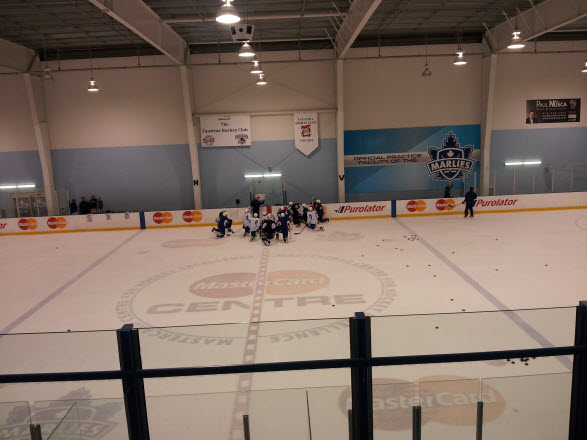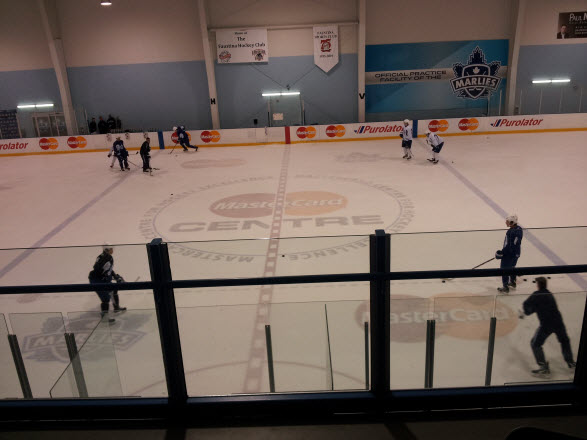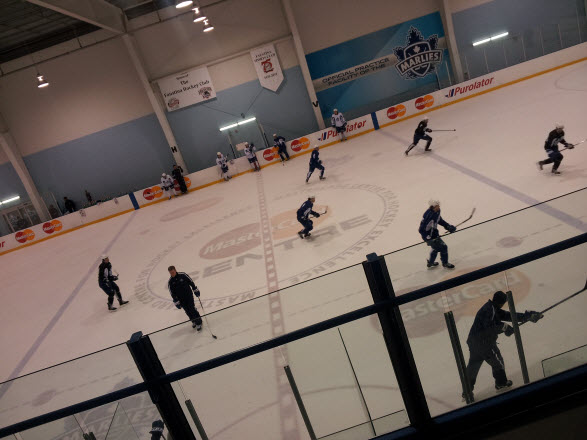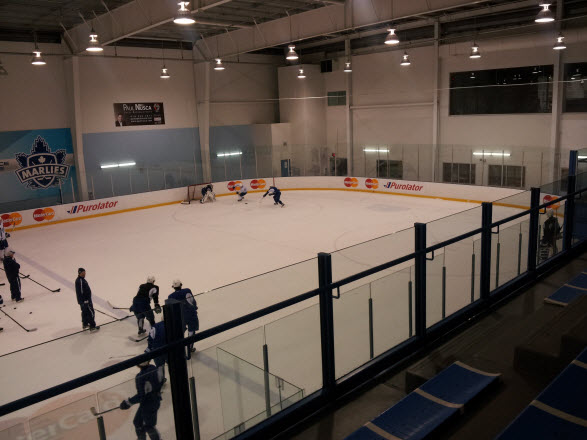The Toronto Marlies 2013-14 season training camp began at the MasterCard Centre for Hockey Excellence on their dedicated pad, located conveniently across the hall from where the Toronto Maple Leafs were holding practice. Yesterday most of these players were across the hall, until a variety of cuts on Tuesday.
Skaters dressed were light in numbers, 13 in all, eight forwards and three defensemen, along with two goaltenders, Garret Sparks and Christopher Gibson.
A highlight of the camp – aside from the drills – was the presence of a pair of prospects on opposite sides of the spectrum.
Josh Leivo, touted as capable of scoring and creating offense, is reunited with former Kitchener Rangers bench boss, Steve Spott who took over the duties as Marlies head coach after incumbent Dallas Eakins was lured away to the bright lights of Edmonton.
Peter Granberg enjoyed a curious, and somewhat furtive rise as a prized defensive prospect. The Swede showed signs of early struggle, finding tempo and pace relatively quicker than his experience in Europe. The plan was to acclimatize to North America, and likely make a late season debut as a Maple Leaf.
Of course, a full season in the AHL is always beneficial and he should be a better player for the experience. Time will tell, but I’ll be watching him with purpose.
Leivo’s highlight was a controlled, poised cut to the net from a sharp angle, dropping his shoulder to protect the puck finishing with a roof-daddy wrister from really in close.
Let’s get to the drills.
DRILLS
After a short warm up the squad were split into three columns. The center would make the first pass to the winger who then skated with it and dumped the puck deep into the zone. The opposite side winger recovered the puck.
This drill was being practised to establish an effective method of recovering a puck dumped into the zone, a strategy more common to the AHL. The defensemen followed up in support behind the forwards and set up along the blueline. Upon puck retrieval, the forwards attempted a shot on goal.
The second instruction started the same way but the puck was then thrown to the defenseman paired at the top of the faceoff circle in the opposite zone. One winger was sent to create forechecking pressure or hurry up the play while the other two forwards maintained a neutral zone stance, ready to pounce on a loose puck, essentially supporting the forechecking pressure.
This drill emphasized a neutral zone forecheck while trying to isolate puck carriers to a side of the ice and take away space, when the puck isn’t deep enough in the zone. The lone forechecker pushes the play to the opposite side of the zone upon which he entered while the two other forwards maintained a lock on that side to create, and then pounce on, a turnover.
The importance of neutral zone play has been documented and the cycle game has less impact than it had in days past. Learning to forecheck through the neutral zone and regroup has an effect of applying pressure high in the offensive zone, while simultaneously limiting neutral zone space and slowing down any potential attack. The speed component is lessened as of the zone entry as a result – or at least the least the aim. Another benefit is the forced dump in should the opposition actually gain ice in the neutral zone and met with numbers/pressure, effectively forcing unwanted dump-ins.
After a brief moment at the drawing board at center ice, the next drill began with a player on each blueline. One player passed across the neutral zone to the opposite blueline who in turn sends it across the ice. The initial passer skates into center ice and circles ready for a pass from the far defenseman. This drill focuses on the regroup likely occurring from a zone entry breakdown. In other words, the puck gets back to the blueline who moves it to a free side as part of a transitional regroup while gaining speed through the neutral zone for the re-entry.
Skaters lined up at the faceoff dots just outside the blueline looking across to the opposite blueline. Player made a pass through the neutral zone and skated behind the lineup then passed a return feed to the diagonal defenseman across the ice, receiving another return pass and then in for a shot on goal. It’s a slight variation of the regroup with a simulation of the broken down play with the player making the loop around the lineup through the zone and coming back out into center ice.
The next drills began below the goal line with man-on-man coverage, first in a 1-on-1 situation in the corner with a puck battle; drill ended with a shot on goal. After that a pair of forwards and defensemen in the opposite corner engaged in man-on-man coverage. The play is inverted with the 1-on-1 and 2-on-2 from either side. The point was to move out of the corner for a shot on goal, with the defensive pairing maintaining inside coverage and separating the man from the puck.
Next drill featured a 3-on-2 scrum with the forwards retrieving the puck from beneath the goal line and skating it quickly up ice meeting a single defenseman for a 3-on-1. Coach Spott stopped the drill to emphasize puck protection and how forwards supporting defense creates the turnover and going the other way. Drill is designed to address transition from the goal line, attacking the puck carrier with numbers in the defensive zone and transitioning to offense.
A moment at the drawing board and the next exercise started at center ice with a dump in and recovery by the goalie leading to a controlled breakout, skating back up ice for a shot on goal. Coaching staff acted as opposition to take away lanes and skating options. Once a shot on goal was made, the forwards turned and came back the other way.
The final drill had the nets placed along the hash marks. The puck was dumped into the zone across the goal line with a 1-on-1 (and then 2-on-2) puck battle with the aim to score in a small area.
The Value of Small Area Games in Ice #Hockey Development #ADM #smallareagames #LTAD http://t.co/Oc31TzAPqC
— Matt Cunningham (@Hockey_matt) September 19, 2013
Ending the session were skates. Goal line to blueline, back to goal line, to red line and back, to opposite blueline, and ...
Well, you get the drill.
Follow the McKeen's team on Twitter:
@KatsHockey
@mckeenshockey



































